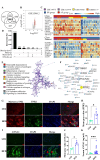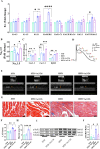ANXA1-FPR2 axis mitigates the susceptibility to atrial fibrillation in obesity via rescuing AMPK activity in response to lipid overload
- PMID: 39709478
- PMCID: PMC11662704
- DOI: 10.1186/s12933-024-02545-z
ANXA1-FPR2 axis mitigates the susceptibility to atrial fibrillation in obesity via rescuing AMPK activity in response to lipid overload
Abstract
Atrial fibrillation (AF) is the most prevalent arrhythmia in clinical practice, and obesity serves as a significant risk factor for its development. The underlying mechanisms of obesity-related AF remain intricate and have yet to be fully elucidated. We have identified FPR2 as a potential hub gene involved in obesity-related AF through comprehensive analysis of four transcriptome datasets from AF patients and one transcriptome dataset from obese individuals, and its expression is up-regulated in both AF and obese individuals. Interestingly, ANXA1, the endogenous ligand of FPR2, was found to exhibit differential expression with AF and obesity. Specifically, it was observed to be down-regulated in AF patients but up-regulated in obese individuals. The susceptibility to AF in obese mice induced by high-fat diet (HFD) was increased following with the FPR2 blocker Boc-2.The administration of exogenous ANXA1 active peptide chain Ac2-26 can mitigate the susceptibility to AF in obese mice by attenuating atrial fibrosis, lipid deposition, oxidative stress injury, and myocardial cell apoptosis. However, this protective effect against AF susceptibility is reversed by AAV9-shAMPK-mediated AMPK specific knockdown in the myocardium. The vitro experiments demonstrated that silencing ANXA1 exacerbated lipid deposition, oxidative stress injury, and apoptosis induced by palmitic acid (PA) in cardiomyocytes. Additionally, Ac2-26 effectively mitigated myocardial lipid deposition, oxidative stress injury, and apoptosis induced by PA. These effects were impeded by FPR2 inhibitors Boc-2 and WRW4. The main mechanism involves the activation of AMPK by ANXA1 through FPR2 in order to enhance fatty acid oxidation in cardiomyocytes, thereby ultimately leading to a reduction in lipid accumulation and associated lipotoxicity. Our findings demonstrate that the ANXA1-FPR2 axis plays a protective role in obesity-associated AF by alleviating metabolic stress in the atria of obese mice, thereby emphasizing its potential as a promising therapeutic target for AF.
Keywords: AMP-activated protein kinase; ANXA1-FPR2; Atrial fibrillation; Lipotoxicity; Obesity.
© 2024. The Author(s).
Conflict of interest statement
Declarations. Competing interests: The authors declare no competing interests.
Figures








Similar articles
-
Methylprednisolone up-regulates annexin A1 (ANXA1) to inhibit the inflammation, apoptosis and oxidative stress of cigarette smoke extract (CSE)-induced bronchial epithelial cells, a chronic obstructive pulmonary disease in vitro model, through the formyl peptide receptor 2 (FPR2) receptors and the adenosine 5'-monophosphate (AMP)-activated protein kinase (AMPK) pathway.Bioengineered. 2022 Feb;13(2):4028-4038. doi: 10.1080/21655979.2022.2031769. Bioengineered. 2022. PMID: 35129068 Free PMC article.
-
Annexin A1 protects against cerebral ischemia-reperfusion injury by modulating microglia/macrophage polarization via FPR2/ALX-dependent AMPK-mTOR pathway.J Neuroinflammation. 2021 May 22;18(1):119. doi: 10.1186/s12974-021-02174-3. J Neuroinflammation. 2021. PMID: 34022892 Free PMC article.
-
Anti-inflammatory Annexin A1 in Periodontitis via Formyl Peptide Receptor 2.J Dent Res. 2025 Aug;104(9):1014-1021. doi: 10.1177/00220345251322151. Epub 2025 Mar 19. J Dent Res. 2025. PMID: 40108522
-
Regulatory role of cardiomyocyte metabolism via AMPK activation in modulating atrial structural, contractile, and electrical properties following atrial fibrillation.Can J Physiol Pharmacol. 2021 Jan;99(1):36-41. doi: 10.1139/cjpp-2020-0313. Epub 2020 Oct 13. Can J Physiol Pharmacol. 2021. PMID: 33049144 Review.
-
Protection Strategies Against Palmitic Acid-Induced Lipotoxicity in Metabolic Syndrome and Related Diseases.Int J Mol Sci. 2025 Jan 18;26(2):788. doi: 10.3390/ijms26020788. Int J Mol Sci. 2025. PMID: 39859502 Free PMC article. Review.
Cited by
-
Metabolic-dysfunction associated steatotic liver disease and atrial fibrillation: A review of pathogenesis.World J Cardiol. 2025 Jun 26;17(6):106147. doi: 10.4330/wjc.v17.i6.106147. World J Cardiol. 2025. PMID: 40575425 Free PMC article. Review.
-
Association between atherogenicity indices and prediabetes: a 5-year retrospective cohort study in a general Chinese physical examination population.Cardiovasc Diabetol. 2025 May 21;24(1):220. doi: 10.1186/s12933-025-02768-8. Cardiovasc Diabetol. 2025. PMID: 40399916 Free PMC article.
-
Cardiac digital twins: a tool to investigate the function and treatment of the diabetic heart.Cardiovasc Diabetol. 2025 Jul 18;24(1):293. doi: 10.1186/s12933-025-02839-w. Cardiovasc Diabetol. 2025. PMID: 40682127 Free PMC article. Review.
-
NDUFAB1 as a Novel Regulator of NEFA-Induced Metabolic Dysfunction in Bovine Adipocytes.Animals (Basel). 2025 May 30;15(11):1618. doi: 10.3390/ani15111618. Animals (Basel). 2025. PMID: 40509084 Free PMC article.
References
-
- Brundel B, Ai X, Hills MT, Kuipers MF, Lip GYH, de Groot NMS. Atrial fibrillation. Nat Rev Dis Primers. 2022;8(1):21. - PubMed
-
- Harada M, Melka J, Sobue Y, Nattel S. Metabolic considerations in atrial fibrillation: mechanistic insights and therapeutic opportunities. Circ J Off J Jpn Circ Soc. 2017;81(12):1749–57. - PubMed
Publication types
MeSH terms
Substances
Grants and funding
LinkOut - more resources
Full Text Sources
Medical
Research Materials
Miscellaneous

